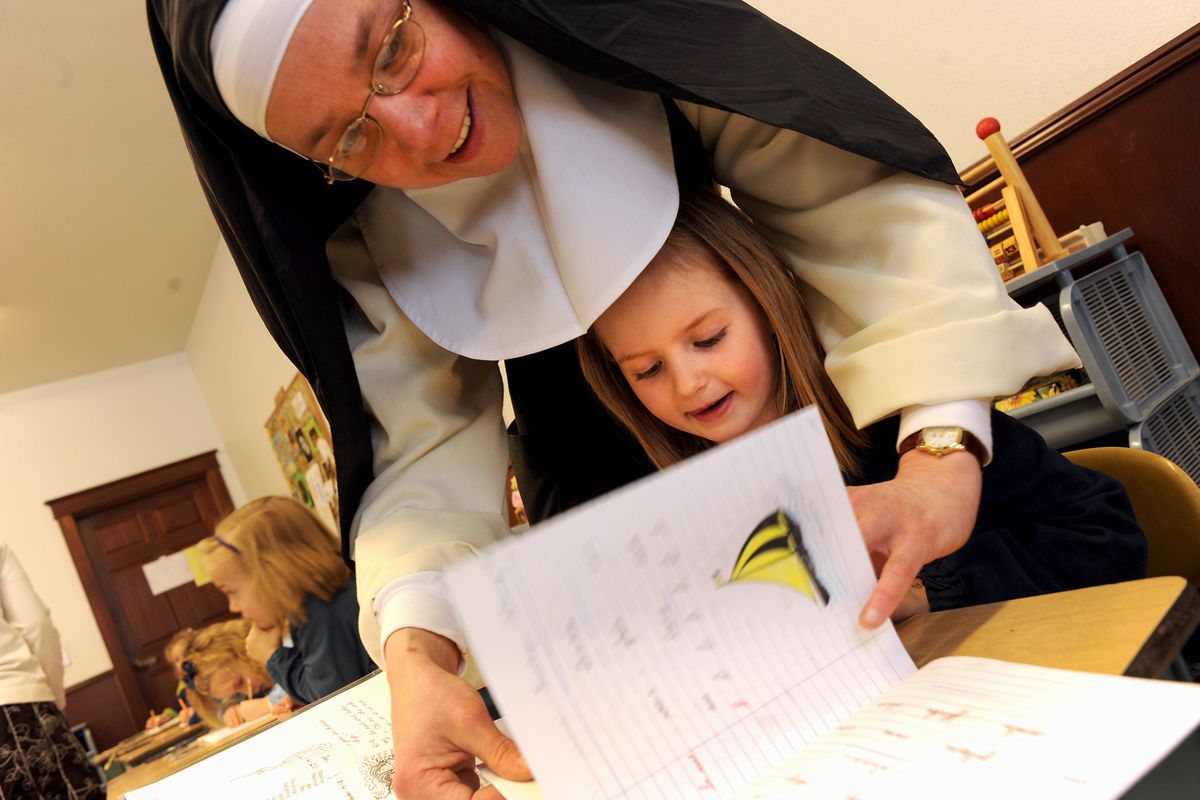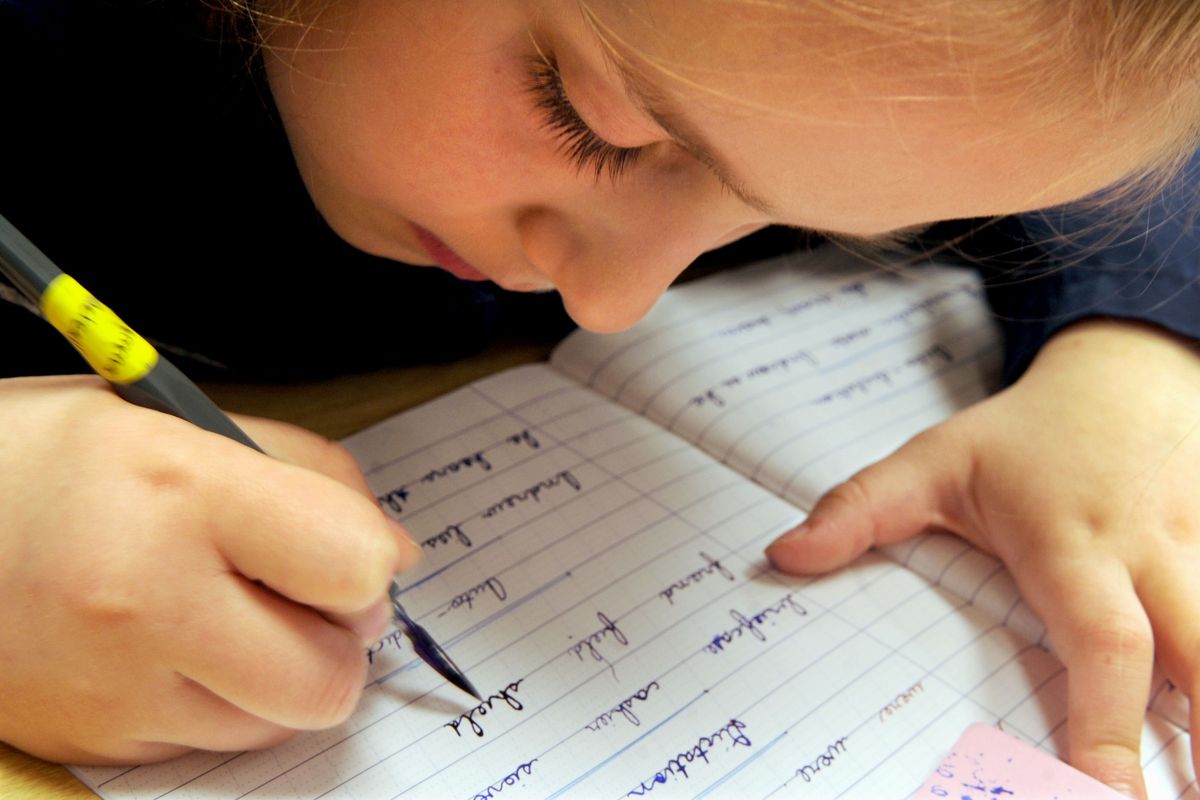Lack of emphasis on cursive has many debating
Sister Mary Martin instructs kindergartner Philomena Bumb during class at Saint Dominic School in Post Falls on March 22. Students at Saint Dominic start learning how to write in cursive while attending kindergarten. (Kathy Plonka)Buy a print of this photo
Cursive writing, the elegant hand used to write the Constitution and other historic documents, was also the script most great-grandparents used to record their thoughts. But young people today might struggle to read the words found on any of those pages, let alone replicate their penmanship.
Cursive is a dying art.
There is disagreement among experts whether cursive’s disappearance is simply an evolution of communication or a detriment to education.
The form of handwriting is briefly taught in mainstream classrooms, usually during third grade, and only practiced afterward as needed. Those lessons have been pushed out by technology and curriculum for standardized testing, local educators say.
“It’s one of many things in education where we have to balance what we are used to with what is going to be important to kids moving into the future,” said Matt Handelman, Coeur d’Alene School District associate superintendent of teaching and learning. “It’s not used enough or needed (enough) to be a priority.”
Cursive is absent from the “common core,” the newest government learning standards for grades K-12, and K-12 public school districts in Washington are not required to teach it.
“There are numerous debates,” said Nathan Olson, spokesman for the state’s Office of the Superintendent of Public Instruction. “From our perspective, the most reasonable thing to do is tell districts that students need to write legibly; they decide how to make that happen. Our focus for the state is more on content than on form.”
However, some educational philosophies, mostly found in private or specialty schools, consider cursive essential to a child’s development.
Local Montessori schools or classrooms still teach cursive, for example, as do two small Catholic schools in Post Falls, the Saint Dominic School and Immaculate Conception Academy. All follow teaching methods founded in Europe, and all start teaching children cursive before first grade.
“Although cursive is not our focus, it is very important to the whole,” said Anne Marie Temple, a teacher at Saint Dominic School and an English curriculum adviser for Immaculate Conception Academy. “It’s part of the basis – connecting letters actually helps them connect thoughts.”
But writing researchers say there’s no clear advantage to cursive versus manuscript.
“We are concerned with how ideas get translated onto paper. I will not argue one or the other,” said Rui Alves, assistant professor at the University of Porto in Portugal and a psychologist who specializes in writing. “What research does say is we have to teach them (students) handwriting.”
Not sure how to sign their names
Students can text, type and tweet, but ask them to sign their name in cursive, and it might bring a blank stare.
“Reading cursive for me is second nature, and it’s not for them,” said Sally Lavin, a North Central High School teacher who has taught English for 32 years. “Texting is second nature for them, and it’s not for me.”
Instructors who have proctored the PSAT or SAT exams regularly tell the story that when students are asked to sign their name in cursive rather than print it, they aren’t sure how to do so.
“Most kids don’t know how to write cursive; they struggle with it,” Lavin said. “Some say they didn’t learn it, and others just have a hard time.”
Students’ writing often is a combination of manuscript and cursive, which means they’ve learned some cursive along the way, she added.
Indeed, the Coeur d’Alene School District and Spokane Public Schools still offer lessons on cursive, but it receives less attention than it used to.
Teacher Kathy Danis spends less time than ever on cursive. “We used to have 30 to 60 minutes per week about four years ago,” said Danis, who works in the Coeur d’Alene School District. Now it’s “maybe 30 minutes a month.”
Rochelle Schultz, another Coeur d’Alene teacher, still teaches cursive to her third-graders, but the reality is “cursive is only used in personal correspondence, rarely in business. Most adults print or type. Learning to write your name in cursive to develop a signature later is the only requirement in an adult life.”
As a teacher, she added, “I would rather spend the time teaching how to construct a good paragraph instead of writing a paragraph in cursive. Maybe cursive can be offered as an elective along with calligraphy in an upper grade.”
Cursive is also still taught in Spokane Public Schools, but whether it will be in the future is uncertain.
“I think it has a place, and it is a foundational skill, but I don’t know that we should spend too much time on it,” said Nancy Stowell, Spokane’s superintendent. “As technology takes over, I think it’s less and less required.”
Using the tools of the past
At Saint Dominic School, first-graders not only embrace cursive writing, they do it with the tools of their ancestors. They wear smocks to avoid staining their clothing as they dip pens into inkwells and carefully blot their letters.
Eileen Eloe, 6, says “s” is the hardest. She knows if she doesn’t hold her pen correctly – “point the pen toward the shoulder,” “hand on the corner (of the book)” and her feet “flat on the ground” – she won’t be able to write her letters.
“It’s very precise,” said Temple, the Saint Dominic School teacher. “It’s not the quantity so much as the quality.”
The students start practicing cursive in kindergarten by tracing letters cut from sandpaper, which “imprints the letter in the child’s mind,” Temple said. As they learn what the letters look like, they also learn the sound, not the letter’s name. Students then use cutouts of the cursive letters, spell out words on their desks and copy them into their books.
The young students start with a pencil – they must earn their way to a dip pen – and they practice every day.
Saint Dominic School, Immaculate Conception Academy and most Montessori schools use what’s called a cursive-first philosophy.
“Cursive writing better corresponds to the nature of the language,” Temple said in a written statement about her schools’ cursive philosophy. “It shows children immediately that words are unities, not simply groups of disconnected letters; it shows that sounds combine to form precise and definite words, which in turn represent ideas.”
Sheryl Engel, a teacher at Woodland Montessori in Spokane, said kids at the private school start tracing letters as early as 2 and writing by 4 years old.
The school is one of a handful of its type in the Spokane area; they encourage a child’s independence in choosing lessons and acknowledge the individual’s natural development. Spokane Public Schools also offers Montessori instruction in a limited capacity for first- through sixth-graders.
Said Engel, “It is much simpler at a young age to write letters in cursive than it is in print. They have a hard time drawing a straight line so they are going to be happier with their writing.”
Additionally, Temple points out in her written statement that “the child can write more freely and quickly in cursive than in print, not needing to lift his hand so often from the page (it is meant to be ‘running’ handwriting), and yet he can feel satisfaction in a beautiful work.”
Engel said students typically don’t have problems moving from writing cursive to reading print.
In his influential cursive-first book, “How We Should Teach Our Children to Write,” author Samuel Blumenfeld writes, “there are few things that help enhance a child’s academic self-esteem more than the development of good handwriting.”
While practice of cursive in area Montessori schools usually ends in sixth grade, students who attend Saint Dominic Academy in Post Falls use the form of handwriting until the end of high school.
“In the older grades, they write their papers and they are expected to write neat,” Temple said. When they write in their notebooks, the handwriting “is a question of respect for the notebook, the person who will be reading it and the subject you are learning.”
Temple added, there’s a “sacredness” to one’s cursive, “a jewel case for what they are learning.”
Sister Andre Dominique, who teaches at the Catholic school, is surprised at the recent surge of interest in cursive. Several publications have published articles focused on the topic. “We’re just doing what we’ve been doing for 200 years,” she said.
The federal government’s new “common core” standards include a composition component but leave out handwriting altogether, which has sparked much debate among researchers and educators.
“There have been more than two decades of research showing that handwriting and spelling are absolutely essential to supporting composing. Not just teaching handwriting for the sake of teaching handwriting, but as support for translating ideas,” said Virginia Berninger, a University of Washington professor of educational psychology who specializes in writing research.
She adds, “Handwriting is like the artist’s paintbrush that allows idea expression.”
But researchers differ on which is better, cursive or manuscript. “You have to go beyond legibility to automaticity – making your hands write as fast as possible – the faster you write the better,” said Alves, the researcher from Portugal. “Cursive might be faster because you join all your letters. With manuscript you have to write a letter then rise your pen. But we need more research to determine if there is more advantage.”
Berninger said, “Some researchers have looked at advantages of printing because what we read in books and on the computer screen is in the printed form … at the same time, there is evidence that cursive does help you pick up speed.”
Beyond ability to write cursive, there’s still a need to teach it, researchers say.
“If children are not taught cursive, there might be a problem because they won’t be able to read it,” said Teresa Limpo, another writing researcher who is a doctoral student at the University of Porto.
There’s also value in teaching both manuscript and cursive because students express individuality through handwriting, some researchers believe.
“Researchers have found that after grade 4 their preferences are dominant; some print, some use cursive, others use a mix,” Berninger said. “But the general principle is teach them both, and then let the children choose.”

